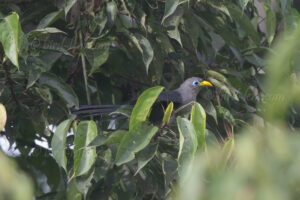 If you are keen to hear the morning roar of the Guerezas (Colobus guereza), just one of seven resident monkey species in the heart of western Kenya, and see a Green Hylia (Hylia prasina) or a Yellowbill (Ceuthmochares aereus) in the semi-darkness of the forest, you should take your time for the Kakamega forest in western Kenya. The forest offers unforgettable encounters for almost every observer, but especially for ornithologists. But observing birds and other animals is not easy in the very dense and high forest. You should always expect that you will only see a fraction of its inhabitants, and often the very ones that the observer most wants to see escape the observer’s gaze. A spotting scope on a sturdy tripod is therefore worth its weight in gold, despite the additional hassle. If you want to avoid disappointment, you should definitely hire one of the local guides, some of whom are extremely knowledgeable. With their help you can also familiarize yourself with the trail system before setting off on your own.
If you are keen to hear the morning roar of the Guerezas (Colobus guereza), just one of seven resident monkey species in the heart of western Kenya, and see a Green Hylia (Hylia prasina) or a Yellowbill (Ceuthmochares aereus) in the semi-darkness of the forest, you should take your time for the Kakamega forest in western Kenya. The forest offers unforgettable encounters for almost every observer, but especially for ornithologists. But observing birds and other animals is not easy in the very dense and high forest. You should always expect that you will only see a fraction of its inhabitants, and often the very ones that the observer most wants to see escape the observer’s gaze. A spotting scope on a sturdy tripod is therefore worth its weight in gold, despite the additional hassle. If you want to avoid disappointment, you should definitely hire one of the local guides, some of whom are extremely knowledgeable. With their help you can also familiarize yourself with the trail system before setting off on your own.
The best viewing conditions for most animals are found in the southern part of the reserve accessible via the village of Shinyalu, 12 km southwest of Kakamega town. At the Isecheno forestry station there is an inn on the edge of the forest, which is the ideal starting point for excursions. At the nearby office of the Kakamega Environmental Education Program (KEEP), you can get a lot of information about the forest as well as tips on current animal viewing opportunities. There is also a small butterfly garden there. Bird watching and especially bird photography takes place under difficult conditions in Kakamega. The requirements for successfully photographing animals in the forest are generally very high. You either fight against excessive darkness when the sky is cloudy or against extreme contrasts caused by patches of light and shadow when the sky is shining. There is almost no transition. That’s why you should definitely aim for high ASA numbers. Without a tripod or a lens with an image stabilizer, you will hardly be able to bring home a sharp image. Photographing moving objects can be a real challenge given the high contrasts. A powerful flash can sometimes help here, but you have to pay a lot of attention to the design of the background so as not to produce unnatural “night shots”. In addition to the appropriate equipment, there is a much more important requirement for successful photo stalking in the Kakamega forest: time and patience. If you stay in the area for at least a week, the chances of interesting encounters of all kinds increase.
In order to meet the growing demand for top images of the rarer species of Palaearctic Bird-lens.com has specifically made trips to remote places. Additionally every chance is used, if a rare bird is around the homeground. This to do everything to ensure excellent photos of the Birds of the Western Palearctic . The yield of pictures also of rare Western Palaearctic birds is very good. There are other nice images of birds, that you will find behind the tab “Picture Shop“. Just give a notice if you need a picture of a bird which is not online.